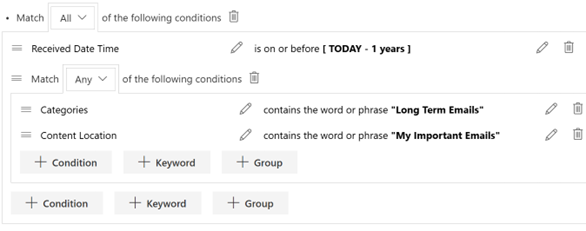How to use these Compliance features, the benefits & what to consider before implementing
While many tasks are required to ensure compliant records management, labeling could be considered one of the most important.
Since the initial release of Advanced Data Governance (ADG), Microsoft 365 (M365) has offered a labeling mechanism that can be utilized for ensuring compliance. We'll be taking a closer look at Microsoft 365 Labels. This article will...
- Outline the two methods of labeling
- define Microsoft 365 Labels,
- list the benefits of M365 Labels, and
- provide overview of factors to consider before using this compliance feature for your RM programs.
For the full version of my presentation on M365 Labels and how to use them, download the free PowerPoint PDF below.
Note: It is important to note that with the latest updates to Microsoft 365, users can only declare records using Enterprise level E5. For this reason, application of labels in M365 is only available if you are using E5 or pairing your M365 with an add-in solution.
2 Types of Labeling
To start off, there are two methods for labeling content: manual and automatic.
1. Manual Application
While the manual process of applying labels one-by-one to content is common for physical records, it has proven to be a less-than reliable option for productive electronic content management (ECM). With such high volumes of organizational digital content, having individual users manually label their own documents can result in disorganization, missing tags, or documents that may not have been tagged or uploaded at all.
2. Automatic Application
Automatically labeling is the more dependable of the two. With this method, content can be labeled based on pattern of information, content type, metadata, or location.
While automatic labeling skips potential for human error, it requires the right tools to work effectively. This is where Microsoft 365 Labels can come in handy.
What are Microsoft 365 Labels?
With Microsoft 365 retention labels, authorized users can classify data across their organization in Microsoft 365 for governance and enforce retention rules based on that classification. Microsoft 365 is also excellent when it comes to data loss protection, having centralized RM capabilities, and APIs for extension to meet compliance requirements for highly regulated industries and public sectors.
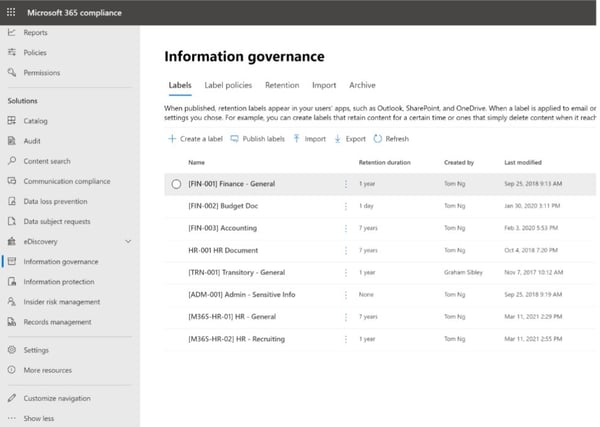
Image shows Retention Labels in Microsoft 365.
Benefits of Microsoft 365 Labels
1. Applicable for Variety of Industries and Policies
Microsoft 365 Labels is available for different types of content with industry regulations and internal policies across an organization.
2. Content can be Marked Immutable
These labels can be created based on specific time periods, and can also be marked as 'records' so other users may not edit or delete the content or label attached to it (content's metadata can still be edited).
3. Disposition Review Process
At the end of a retention period, authorized users can either dispose of content from Microsoft 365, re-label the content, or extend the retention period.
4. Manual and Auto-Apply
Users have the option between a label policy that requires labels to be published for each content piece (manual method) or can be auto-applied (automatically applying a label whenever content meets criteria previously specified for that label).
5. Multiple Platforms
These labels can be applied to files, emails, groups, and more on the following platforms:
- Exchange Online
- Folders and emails in Outlook
- SharePoint Online
- Sites, document libraries, folders, items
- OneDrive for Business
- Folders and items
- Microsoft 365 Groups
- Group level
- MS Teams
- Public and Private Channels
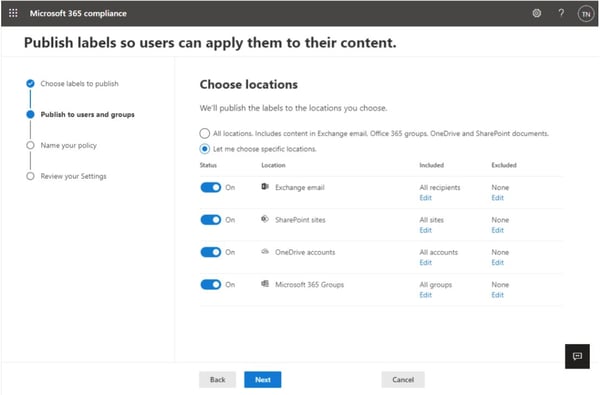
Image shows Label Publishing Locations.
Microsoft 365 Labels provides users with excellent policy-based capabilities around labeling and tagging. But before implementing these compliance features for your RM program, what are some things to consider?
Things to Consider with M365 Labels
1. M365 is just part of a whole data ecosystem
We've reviewed some of the benefits of labeling within Microsoft 365. And while M365 offers a way to import and archive from other systems (see image below), we need to consider: what do we do with the content at the original source? And what of the content M365 does not manage, such as physical records?
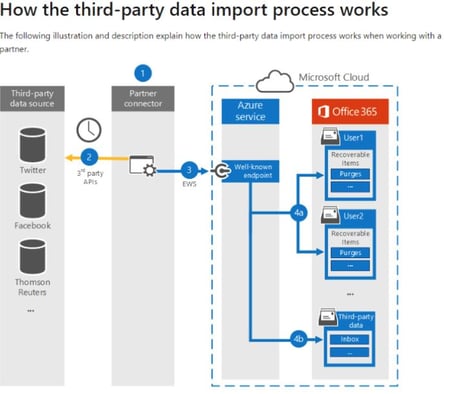
2. Limited File Plan Options
Microsoft 365 Labels can only be associated to a single hierarchical File Plan (up to 3 levels). However, record categories (aka labels) are usually organized hierarchically based on different business functions. So this feature can be limiting since most organizations require multiple, hierarchical File Plans which are individually secured and managed with no limitations to the number of levels.
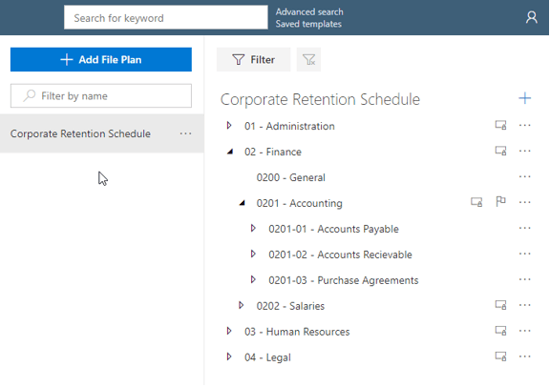
Image shows an example of a M365 File Plan.
3. Not All Versions Tracked and Kept
In Microsoft 365, not all versions are tracked and kept. If versioning is somehow turned off, only the final copy of the file will be kept as a record when the Label is applied. If some of the versions are lost, there would be a loss of information and this could put organizations at risk.
4. Up To 7 Days to Apply Labels
Content is not immediately protected and retained. It can take up to 7 days to apply labels as seen in charts below), and content can be deleted during this period of time. This leaves organizations vulnerable to data loss, tampering, and accidental deletion during this time period.


5. Retention Lifecycle Not Always Sequential
Another downside is that the retention lifecycle is not always sequential: there can be multiple paths or stages of review in a workflow before a piece of content can be destroyed.
5. Upgrade Costs
Applying labels automatically in Microsoft 365 and requires either a Enterprise E5 license or an Advanced Compliance Add-on.* Since the Enterprise E3 is often the standard license, this would require a costly upgrade to have achieve these capabilities (see chart below).
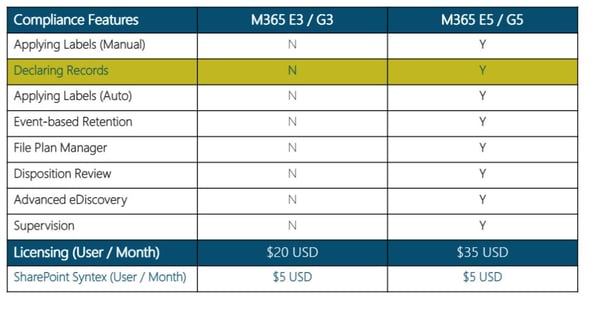
Image shows M365 license model capabilities and costs.
6. And More
See other items in my presentation slides by downloading the PPT slides below.
Summary
The Microsoft 365 Labels compliance features allow authorized users to manually or automatically apply label policies to a variety of Microsoft content and perform disposition reviews. However, some things to consider prior to implementing is that these tools can only be associated to a single hierarchical File Plan, take up to 7 days to apply, and that retention lifecycles are not always sequential. The ability to apply labels automatically requires either a costly Advanced Compliance Add-on or upgrade to Enterprise E5 license.
In addition to knowing benefits and considering potential gaps, it's critical to review and understand your own organization's content and labeling requirements to know if these compliance features check all the boxes for your organization's RM labeling needs.
For my full presentation on this topic, including detailed screenshots, a how-to and the full list of things to consider, please download the free PowerPoint PDF below.
You can also check out our article on more Microsoft 365 Features with the SharePoint Syntex release and view our feature comparison chart showcasing the capabilities that both Microsoft 365 and our Cloud Records Management Solution, Collabspace, offer.
If you have any additional questions, contact us with your questions. As a Microsoft Gold partner, our Services Team comes with expertise in Microsoft 365 and information governance best practices. We can help you make the most of your Microsoft investment or explore options that best suit your organizational processes and compliance needs.
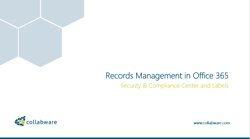
* The capability to apply labels automatically requires a Microsoft 365 Enterprise E5 license for each user who has permissions to edit content that's been automatically labeled in a site or their mailbox is selected for automatic labeling. Users who simply have read-only access to content or reply to labeled emails do not require this license.



